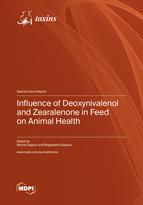Influence of Deoxynivalenol and Zearalenone in Feed on Animal Health
A special issue of Toxins (ISSN 2072-6651). This special issue belongs to the section "Mycotoxins".
Deadline for manuscript submissions: closed (31 January 2023) | Viewed by 25660
Special Issue Editors
Interests: mycotoxins; detection; feed; mycotoxicosis; diagnostics; animal pathology; human pathology
Special Issues, Collections and Topics in MDPI journals
Interests: mycotoxins; detection; feed; low doses; mycotoxicosis; diagnostics; animal pathology; human pathology
Special Issues, Collections and Topics in MDPI journals
Special Issue Information
Dear Colleagues,
Zearalenone, deoxynivalenol, and their metabolites are among the most frequently encountered mycotoxins in plant materials. Their presence compromises the health quality of foodstuffs and feedstuffs, and increases the risk of ischemia and reperfusion injury, stress-related intestinal disorders, as well as endocrine, metabolic, and immune disorders. These problems are resolved on an individual basis by selecting the appropriate combination of measures. The symptoms and health consequences of high mycotoxin doses are generally known. However, small doses can cause disease without clinical symptoms or they can interact with the host body at various stages of life. Due to this ambiguous dose–response relationship, the symptoms associated with high mycotoxin doses cannot be easily extrapolated to low doses. The interactions between mycotoxins and between mycotoxins and physiological processes in cells, tissues, and microorganisms are also problematic. Mycotoxins present in feed come into direct contact with the intestinal mucosa. A healthy gastrointestinal tract comprises active cells and tissues with high protein metabolic turnover rates. Cells and tissues are often targeted by mycotoxins. Some mycotoxins inhibit protein synthesis. For instance, deoxynivalenol ingested in small doses inhibits the uptake of substrates responsible for protein transport across intestinal walls. On the other hand, zearalenone has estrogenic properties, and low doses of this mycotoxin stimulate proliferative processes. Mycotoxins also influence the activity of local and general immune systems, and their adverse effects become manifested in immunosuppressed hosts. Mycotoxins can also suppress the host’s immune system, thus increasing the risk of disorders caused by microorganisms, intestinal enzymes, and other toxins in the digestive tract without the clinical symptoms that are characteristic of mycotoxicoses.
To address these important concerns, we will be leading the Special Issue of Toxins, titled “The Influence of Deoxynivalenol and Zearalenone in Feed on Animal Health”, as Guest Editors. We invite you to submit manuscripts to this issue.
Prof. Dr. Maciej T. Gajęcki
Prof. Dr. Magdalena Gajęcka
Guest Editors
Manuscript Submission Information
Manuscripts should be submitted online at www.mdpi.com by registering and logging in to this website. Once you are registered, click here to go to the submission form. Manuscripts can be submitted until the deadline. All submissions that pass pre-check are peer-reviewed. Accepted papers will be published continuously in the journal (as soon as accepted) and will be listed together on the special issue website. Research articles, review articles as well as short communications are invited. For planned papers, a title and short abstract (about 100 words) can be sent to the Editorial Office for announcement on this website.
Submitted manuscripts should not have been published previously, nor be under consideration for publication elsewhere (except conference proceedings papers). All manuscripts are thoroughly refereed through a double-blind peer-review process. A guide for authors and other relevant information for submission of manuscripts is available on the Instructions for Authors page. Toxins is an international peer-reviewed open access monthly journal published by MDPI.
Please visit the Instructions for Authors page before submitting a manuscript. The Article Processing Charge (APC) for publication in this open access journal is 2700 CHF (Swiss Francs). Submitted papers should be well formatted and use good English. Authors may use MDPI's English editing service prior to publication or during author revisions.
Keywords
- mycotoxins
- detection
- feed
- low doses
- mycotoxicosis
- diagnostics
- gastroenterology
- endocrinology
- animal pathology








